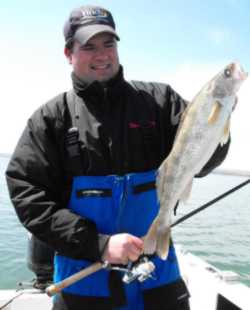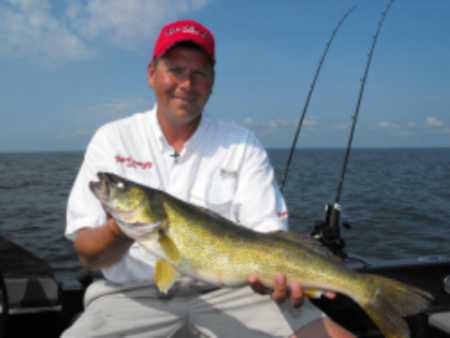|
Spinners are incredible tools for catching
walleyes and this presentation in some form offers the angler
a surprising amount of versatility. For many anglers, spinner
harnesses are used in conjunction with bottom bouncers.
This presentation is extremely versatile and effective but
bottom bouncers aren’t the only method for presenting
spinners. From open water trolling on the Great Lakes to
precise tight quarter tactics that probe weed edges on small
natural lakes… spinners should be an important tool
for walleye anglers to consider at some point each season.
Spinners offer the angler the advantage of great latitudes
of speed in the sense that you can productively fish anywhere
from half a mile per hour to almost two miles per hour or
more. To get the spinner blade to turn at the slower end
of the spectrum, use a metal clevis instead of the plastic
quick clip variety along with using rounder cupped blades
(Colorado). Smaller blades also seem to turn easier at slower
speeds than larger blades. At a faster pace, long willow
leaf shaped blades tend to handle increases in speed better
and it also seems to help if the snell itself is tied with
heavier line as the heavier line has less of a tendency
to twist at higher speeds. Tipping options vary with night
crawlers probably being the most popular bait for tipping
but night crawlers are not the only option. Leeches work
well behind a spinner but generally won’t handle as
much speed as a crawler. When using leeches on spinner harnesses,
what works well for me is lightly stepping on the leech
with my foot to kill the leech and hooking the leech through
the nose (narrow end). This keeps the leech from spinning
so much and twisting around the hook. Minnows also work
well at times as well… again hooking the minnow through
the head so that the minnow doesn’t spin out of control
at faster speeds.
Another tipping option that has really begun to catch on
in the past few years is Berkley Gulp! I have had a lot
of success with Gulp! particularly the leeches and crawlers
especially late to mid summer when pulling harnesses at
speeds of one mile per hour or more. Whatever you tip with,
just make sure to watch the harness next to the boat to
make sure that the bait or Gulp! is flowing naturally behind
the spinner to prevent extra line twist and also, from my
own experiences it seems like bait that isn’t spinning
just seems to catch more fish. What also works well in many
applications is to use as heavy of line as possible in the
sense that heavier line tends to track through the water
better with less twisting. Many anglers tie spinner harnesses
with ten to twenty pound monofilament.
Tactics for presenting spinners varies across the walleye
belt. On the massive reservoirs located on the Missouri
River System in the Dakotas, bottom bouncers originated
several years ago and in many areas, a bottom bouncer is
a very common and effective way to present spinners to walleyes.
The key to the bottom bouncer’s success is again versatility.
Bottom bouncers can be fished below the boat or behind the
boat. Bottom bouncers are fairly snag resistant and follow
the contour of the bottom extremely well. Bottom bouncers
also telegraph the bottom very well so that an angler can
get a more intimate understanding of the lake bottom. Anglers
can use bottom bouncers to troll expansive flats with a
more horizontal presentation back behind the boat or even
behind planer boards but this same piece of equipment is
versatile enough to fish near vertically with precision
to probe corners and break lines in tight quarters.
Anglers trolling spinners for suspended fish might incorporate
bottom bouncers but often, large split shot or trolling
weights are used to position the spinners at different depths
through out the water column. Bigger water often calls for
much larger blades.

Bottom bouncers combined with spinner harnesses are
an extremely effective presentation for working structure
on the reservoirs located on the Missouri River System
in the Dakotas. Pictured is the author, Jason Mitchell,
admiring a Lake Sharpe walleye. |
In my experiences, blade shape and size
combined with speed is much more crucial to experiment
with than color but the fish do seem to respond to different
combinations of general color combinations like chrome
or gold, chartreuse, blue. Little details however like
scale patterns, eyes and fleck are meaningless to the
fish in the sense that if a fish can see these small
details on the blade, you are fishing the spinner to
slow to even turn the blade. These little details are
designed to catch anglers who think the blades look
cool. What is important is balancing the harness. Large
blades require more and larger beads and vice versa.
Hooks should be sharp and far enough back from the blade
for better hooking percentages. Bait should be fresh
and hooked in such a way to cause the bait to just slide
and wobble through the water without spinning. High
quality ball barrel swivels should be used above the
harness to take out as much line twist as possible.
The fundamentals of using spinners to catch walleyes
are fairly simple and this presentation is extremely
versatile in the sense that spinners can be used to
catch both aggressive and neutral fish. |
| Many anglers store their harnesses and
rigs on foam pool noodles. These pool noodles can be
found in the toy section of many large retail stores.
Another adaptation you can make to the harness when
you are tying them is to put a bobber stop between the
first bead and the second bead from the hook. This allows
you to slide the rest of the beads and blade up the
snell further which can pay dividends at times when
the fish are just following the bait and biting short.
|

Pictured is Dean Nathe, Operations Manager for Yar-Craft
Boats with a Green Bay walleye that was caught by
trolling spinners in conjunction with trolling weights
and planer boards while filming a television show
with the author. |
Also, many anglers are quick to put a new fresh crawler
on after getting nipped short but if the fish are hitting
short, you might be surprised how well half a crawler works.
On a harness, just let the back hook hang free when using
half a crawler unless debris on the bottom is an issue for
snagging.
Spinner harnesses in some capacity or another work well
on rivers, reservoirs, natural lakes and the big water of
the Great Lakes. Different regions often require specific
adaptations as using spinners on the Great Lakes is a much
different program than using this presentation on a small
natural lake but regardless of region, this presentation
is so adaptable. The bottom line is that this presentation
is also extremely effective and easy to use.
|



